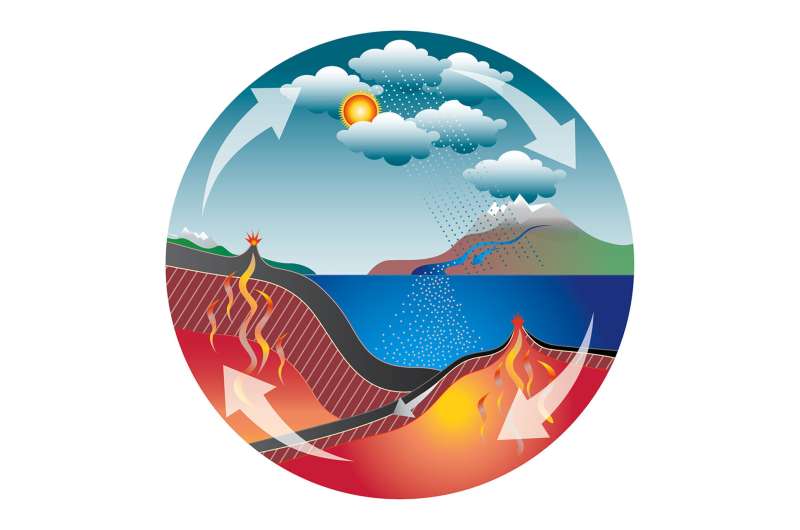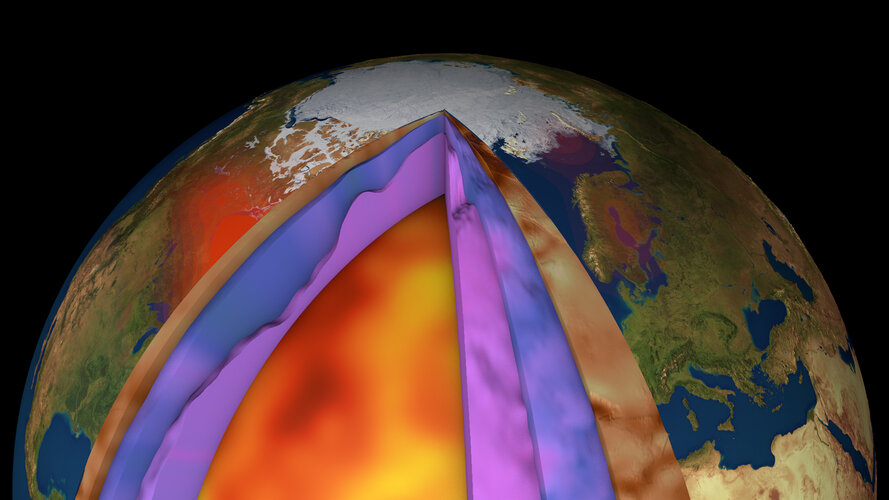
Copernical Team
How the habitability of exoplanets is influenced by their rocks

The weathering of silicate rocks plays an important role to keep the climate on Earth clement. Scientists led by the University of Bern and the Swiss national center of competence in research (NCCR) PlanetS, investigated the general principles of this process. Their results could influence how we interpret the signals from distant worlds—including such that may hint towards life.
The conditions on Earth are ideal for life. Most places on our planet are neither too hot nor too cold and offer liquid water. These and other requirements for life, however, delicately depend on the right composition of the atmosphere.
Gravity mission still unearthing hidden secrets

Despite ESA’s GOCE mission ending over seven years ago, scientists continue to use this remarkable satellite’s gravity data to delve deep and unearth secrets about our planet. Recent research shows how scientists have combined GOCE data with measurements taken at the surface to generate a new model of Earth’s crust and upper mantle. This is the first time such a model has been created this way – and it is shedding new light on processes of plate tectonics, which, in turn, are related to phenomena such as earthquakes and volcanic eruptions.
ESA defines elements of future European space transportation solutions

China advances space cooperation in 2020: blue book
 China actively promoted international space cooperation in 2020, offering satellite exports and launches, cooperative research and application services to the world, according to a recent report on China's aerospace industry.
By the end of last year, 51 Chinese rockets had launched 59 foreign commercial satellites into space, said the 2020 Blue Book of China Aerospace Science and Technolog
China actively promoted international space cooperation in 2020, offering satellite exports and launches, cooperative research and application services to the world, according to a recent report on China's aerospace industry.
By the end of last year, 51 Chinese rockets had launched 59 foreign commercial satellites into space, said the 2020 Blue Book of China Aerospace Science and Technolog The Robot will see you now
 In the era of social distancing, using robots for some health care interactions is a promising way to reduce in-person contact between health care workers and sick patients. However, a key question that needs to be answered is how patients will react to a robot entering the exam room.
Researchers from MIT and Brigham and Women's Hospital recently set out to answer that question. In a study
In the era of social distancing, using robots for some health care interactions is a promising way to reduce in-person contact between health care workers and sick patients. However, a key question that needs to be answered is how patients will react to a robot entering the exam room.
Researchers from MIT and Brigham and Women's Hospital recently set out to answer that question. In a study NASA, Blue Origin Partner to bring lunar gravity conditions closer to Earth
 At one-sixth that of Earth, the unique gravity of the lunar surface is one of the many variable conditions that technologies bound for the Moon will need to perform well in. NASA will soon have more options for testing those innovations in lunar gravity thanks to a collaboration with Blue Origin to bring new testing capabilities to the company's New Shepard reusable suborbital rocket system.
At one-sixth that of Earth, the unique gravity of the lunar surface is one of the many variable conditions that technologies bound for the Moon will need to perform well in. NASA will soon have more options for testing those innovations in lunar gravity thanks to a collaboration with Blue Origin to bring new testing capabilities to the company's New Shepard reusable suborbital rocket system. Developing Virtual Partners to Assist Military Personnel
 Increasing worker knowledge, productivity, and efficiency has been a seemingly never ending quest for the military as well as commercial companies. Today, military personnel are expected to perform a growing number of complex tasks while interacting with increasingly sophisticated machines and platforms.
Artificial intelligence (AI) enabled assistants have the potential to aid users as the
Increasing worker knowledge, productivity, and efficiency has been a seemingly never ending quest for the military as well as commercial companies. Today, military personnel are expected to perform a growing number of complex tasks while interacting with increasingly sophisticated machines and platforms.
Artificial intelligence (AI) enabled assistants have the potential to aid users as the Exotrail signs license with Thales Alenia Space for ExoOPS
 Exotrail signed a license contract with Thales Alenia Space for ExoOPS, its simulation and operation software dedicated to space mobility.
Thales Alenia Space, Joint Venture between Thales (67%) and Leonardo (33%), becomes a customer of ExoOPS - Mission Design. Thales Alenia Space and Exotrail signed the contract in January. ExoOPS - Mission Design is Exotrail's simulation and mission desi
Exotrail signed a license contract with Thales Alenia Space for ExoOPS, its simulation and operation software dedicated to space mobility.
Thales Alenia Space, Joint Venture between Thales (67%) and Leonardo (33%), becomes a customer of ExoOPS - Mission Design. Thales Alenia Space and Exotrail signed the contract in January. ExoOPS - Mission Design is Exotrail's simulation and mission desi A better way to measure acceleration
 You're going at the speed limit down a two-lane road when a car barrels out of a driveway on your right. You slam on the brakes, and within a fraction of a second of the impact an airbag inflates, saving you from serious injury or even death.
The airbag deploys thanks to an accelerometer - a sensor that detects sudden changes in velocity. Accelerometers keep rockets and airplanes on the
You're going at the speed limit down a two-lane road when a car barrels out of a driveway on your right. You slam on the brakes, and within a fraction of a second of the impact an airbag inflates, saving you from serious injury or even death.
The airbag deploys thanks to an accelerometer - a sensor that detects sudden changes in velocity. Accelerometers keep rockets and airplanes on the Explaining Parker Solar Probe's magnetic puzzle
 When NASA's Parker Solar Probe sent back the first observations from its voyage to the Sun, scientists found signs of a wild ocean of currents and waves quite unlike the near-Earth space much closer to our planet. This ocean was spiked with what became known as switchbacks: rapid flips in the Sun's magnetic field that reversed direction like a zig-zagging mountain road.
Scientists think pi
When NASA's Parker Solar Probe sent back the first observations from its voyage to the Sun, scientists found signs of a wild ocean of currents and waves quite unlike the near-Earth space much closer to our planet. This ocean was spiked with what became known as switchbacks: rapid flips in the Sun's magnetic field that reversed direction like a zig-zagging mountain road.
Scientists think pi 